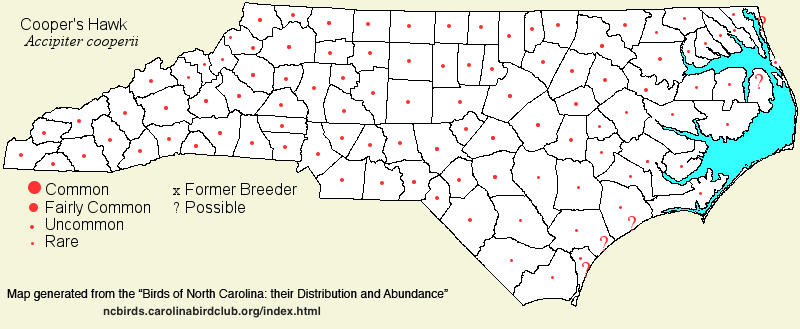 |  |
|
Cooper's Hawk - Astur cooperii ACCIPITRIDAE Members: | Search Common: Search Scientific: |
|
|
|||||||
| General Comments |
This Accipiter was apparently a reasonably numerous breeding species in the first half of the 20th Century, even nesting toward the coast. However, for whatever reason (DDT?), Cooper's Hawks went into a steep decline in the 1960's-1980's, especially as a breeder. Thankfully, numbers have bounced back since at least 1990, and this formerly uncommon bird is now seen more often than the smaller Sharp-shinned Hawk during the summer and in much of the remainder of the year. This species is more tolerant of humans and suburban habitats, and birds breed in a variety of forests and woodlots, occasionally in cities and towns. At other seasons, like the Sharp-shinned Hawk, it favors a mix of forests or woodlots interspersed with fields and is not normally found inside deep forests. Unlike the Sharp-shinned, Cooper's frequently perch in the open, such as in a tree in a field or on a fencepost.
In 2025, the AOS moved this species and the American Goshawk out of the genus Accipiter to now Astur; so this species is currently named as Astur cooperii. | ||||||
| Breeding Status | Breeder | ||||||
| NC BRC List | Definitive | ||||||
| State Status | |||||||
| U.S. Status | |||||||
| State Rank | S3S4B,S4N | ||||||
| Global Rank | G5 | ||||||
| Coastal Plain | Permanent resident, with migratory movements; increasing. Generally uncommon in migration and as a winter resident, not obviously more numerous in fall migration. Breeds over most of the region but very rare if not casual along and very near the immediate coast; rare in the Tidewater area, and rare to very uncommon over the remainder of the province. Notable were 3 active nests observed in 2021 in the northern parts of Dare -- Corolla, Southern Shores, and on Roanoke Island. Peak counts: a published report of 134 in fall migration along the coast on a single day [Chat 40:47 link] is believed to be a mis-identification; 14, Morehead City CBC, 19 De 2010; 12, Cape Hatteras, 19 Oct 1993. | ||||||
| Piedmont | Permanent resident, with some migratory movements; increasing. Uncommon, but widespread and often seen, in fall, winter, and spring, and rare to uncommon as a breeder. Nests over the entire province. Peak counts:? | ||||||
| Mountains | Permanent resident, with some migratory movements; slightly increasing. Uncommon fall migrant, rare to very uncommon in winter and spring, and generally rare in summer, not breeding at higher elevations (mainly over 4,500 feet). Peak counts: | ||||||
| Finding Tips |
You simply cannot search for this species; you must be afield frequently, and keep your eyes open to hawks overhead and darting across fields. Unlike the Sharp-shinned, which shuns perching in the open, the Cooper's has a proclivity for perching in the open, at times; they can be seen occasionally on fence posts, in lone trees in fields, and in parks in cities. Of course, they are most often seen darting across a field or in the sky. ** | ||||||
| Attribution | LeGrand[2025-09-11], LeGrand[2023-03-20], LeGrand[2021-09-03] | ||||||
| NC Map Map depicts all counties with a report (transient or resident) for the species. | Click on county for list of all known species. |
| NC Breeding Season Map Map depicts assumed breeding season abundance for the species. |  |